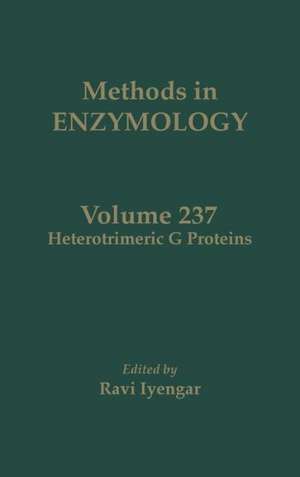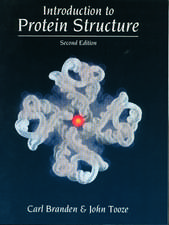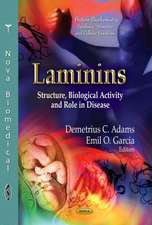Heterotrimeric G Proteins: Methods in Enzymology, cartea 237
John N. Abelson, Melvin I. Simon Ravi Iyengaren Limba Engleză Hardback – 25 iul 1994
Din seria Methods in Enzymology
- 28%
 Preț: 801.23 lei
Preț: 801.23 lei - 32%
 Preț: 802.54 lei
Preț: 802.54 lei - 23%
 Preț: 461.36 lei
Preț: 461.36 lei - 23%
 Preț: 460.60 lei
Preț: 460.60 lei - 23%
 Preț: 439.86 lei
Preț: 439.86 lei - 23%
 Preț: 448.15 lei
Preț: 448.15 lei - 23%
 Preț: 451.42 lei
Preț: 451.42 lei - 23%
 Preț: 445.18 lei
Preț: 445.18 lei - 5%
 Preț: 557.15 lei
Preț: 557.15 lei - 23%
 Preț: 450.67 lei
Preț: 450.67 lei - 23%
 Preț: 446.23 lei
Preț: 446.23 lei - 23%
 Preț: 435.87 lei
Preț: 435.87 lei - 23%
 Preț: 445.94 lei
Preț: 445.94 lei - 23%
 Preț: 459.55 lei
Preț: 459.55 lei - 23%
 Preț: 460.02 lei
Preț: 460.02 lei - 23%
 Preț: 456.61 lei
Preț: 456.61 lei - 23%
 Preț: 450.54 lei
Preț: 450.54 lei - 23%
 Preț: 453.47 lei
Preț: 453.47 lei - 5%
 Preț: 565.37 lei
Preț: 565.37 lei - 23%
 Preț: 450.67 lei
Preț: 450.67 lei - 23%
 Preț: 464.33 lei
Preț: 464.33 lei - 23%
 Preț: 441.49 lei
Preț: 441.49 lei - 23%
 Preț: 447.44 lei
Preț: 447.44 lei - 23%
 Preț: 459.13 lei
Preț: 459.13 lei - 23%
 Preț: 450.38 lei
Preț: 450.38 lei - 23%
 Preț: 445.80 lei
Preț: 445.80 lei - 23%
 Preț: 445.35 lei
Preț: 445.35 lei - 23%
 Preț: 442.53 lei
Preț: 442.53 lei - 23%
 Preț: 450.38 lei
Preț: 450.38 lei - 23%
 Preț: 448.60 lei
Preț: 448.60 lei - 23%
 Preț: 447.57 lei
Preț: 447.57 lei - 23%
 Preț: 458.97 lei
Preț: 458.97 lei - 23%
 Preț: 440.90 lei
Preț: 440.90 lei - 23%
 Preț: 448.15 lei
Preț: 448.15 lei - 23%
 Preț: 466.84 lei
Preț: 466.84 lei - 23%
 Preț: 451.42 lei
Preț: 451.42 lei - 23%
 Preț: 453.64 lei
Preț: 453.64 lei - 23%
 Preț: 459.13 lei
Preț: 459.13 lei - 23%
 Preț: 457.49 lei
Preț: 457.49 lei - 23%
 Preț: 447.44 lei
Preț: 447.44 lei - 5%
 Preț: 561.34 lei
Preț: 561.34 lei - 23%
 Preț: 447.57 lei
Preț: 447.57 lei - 23%
 Preț: 453.35 lei
Preț: 453.35 lei - 23%
 Preț: 441.95 lei
Preț: 441.95 lei - 23%
 Preț: 450.38 lei
Preț: 450.38 lei - 23%
 Preț: 449.19 lei
Preț: 449.19 lei - 23%
 Preț: 456.02 lei
Preț: 456.02 lei - 23%
 Preț: 455.11 lei
Preț: 455.11 lei - 23%
 Preț: 455.87 lei
Preț: 455.87 lei
Preț: 449.66 lei
Preț vechi: 583.98 lei
-23% Nou
Puncte Express: 674
Preț estimativ în valută:
86.04€ • 90.06$ • 71.61£
86.04€ • 90.06$ • 71.61£
Carte tipărită la comandă
Livrare economică 31 martie-14 aprilie
Preluare comenzi: 021 569.72.76
Specificații
ISBN-13: 9780121821388
ISBN-10: 0121821382
Pagini: 561
Dimensiuni: 152 x 229 x 32 mm
Greutate: 0.95 kg
Editura: ELSEVIER SCIENCE
Seria Methods in Enzymology
ISBN-10: 0121821382
Pagini: 561
Dimensiuni: 152 x 229 x 32 mm
Greutate: 0.95 kg
Editura: ELSEVIER SCIENCE
Seria Methods in Enzymology
Public țintă
Biochemists, molecular biologists, neurophysiologists, neurochemists, cell biologists, pharmacologists, and neuroendocrinologists.Cuprins
Ga Subunits:T. Wieland and K.H. Jakobs, Measurement of Receptor-Stimulated Guanosine 5'-O-((-Thio)triphosphate Binding by G Proteins.P. Gierschik, T. Bouillon, and K.H. Jakobs, Receptor-Stimulated Hydrolysis of Guanosine 5'-Triphosphate in Membrane Preparations.E.M. Ross and T. Higashijima, Regulation of G-Protein Activation by Mastoparans and Other Cationic Peptides.D.J. Carty and R. Iyengar, Guanosine 5'-O-((-Thio)triphosphate Binding Assay for Solubilized G Proteins.J. Moss, R.S. Haun, S.-C. Tsai, C.F. Welsh, F.-J.S. Lee, S.R. Price, and M. Vaughan, Activation of Cholera Toxin by ADP-Ribosylation Factors: 20-kDa Guanine Nucleotide-Binding Proteins.D.J. Carty, Pertussis Toxin-Catalyzed ADP-Ribosylation of G Proteins.R.R. Vaillancourt, N. Dhanasekaran, and A.E. Ruoho, Synthesis and Use of Radioactive Photoactivatable NAD+ Derivatives as Probes for G-Protein Structure.M.M. Rasenick, M. Talluri, and W.J. Dunn, III, Photoaffinity Guanosine 5'-Triphosphate Analogs as a Tool for the Study of GTP-Binding Proteins.L. Birnbaumer, D. Grenet, F. Ribeiro-Neto, and J. Codina, Preparation of Activated ( Subunits of Gs and Gis: From Erythrocyte to Activated Subunit.T. Katada, K. Kontani, A. Inanobe, I. Kobayashi, Y. Ohoka, H. Nishina, and K. Takahashi, Purification and Separation of Closely Related Members of Pertussis Toxin-Substrate G Proteins.J. Bigay and M. Chabre, Purification of Transducin.E. Lee, M.E. Linder, and A.G. Gilman, Expression of G-Protein a Subunits in Escherichia coli.I.-H. Pang, A.V. Smrcka, and P.C. Sternweis, Synthesis and Applications of Affinity Matrix Containing Immobilized (( Subunits of G Proteins.J.L. Blank and J.H. Exton, Purification of Activated and Heterotrimeric Forms of Gq Proteins.G.L. Waldo, J.L. Boyer, and T.K. Harden, Purification of Phospholipase C-Activating G Protein, G11, from Turkey Erythrocytes.J.R. Hepler, T. Kozasa, and A.G. Gilman, Purification of Recombinant Gqa, G11a, and G16a from Sf9 Cells.S.G. Graber, R.A. Figler, and J.C. Garrison, Expression and Purification of G-Protein a Subunits Using Baculovirus Expression System.E.J. Neer, B.M. Denker, T.C. Thomas, and C.J. Schmidt, Analysis of G-Protein a and (Subunits by in Vitro Translation.Y. Audigier, Assays for Studying Functional Properties of in Vitro Translated Gsa Subunit.S.M. Mumby and M.E. Linder, Myristoylation of G- Protein a Subunits.G. Milligan, Specificity and Functional Applications of Antipeptide Antisera Which Identify G-Protein a Subunits.K.-L. Laugwitz, K. Spicher, G. Schultz, and S. Offermanns, Identification of Receptor-Activated G Proteins: Selective Immunoprecipitation of Photolabeled G-Protein a Subunits.J. Lyons, Identification of Mutant Forms of G-Protein a Subunits in Human Neoplasia by Polymerase Chain Reaction-Based Techniques.P.V. Gejman and L.S. Weinstein, Detection of Mutations and Polymorphisms of the Gsa Subunit Gene by Denaturing Gradient Gel Electrophoresis.S. Winitz, M. Russell, and G.L. Johnson, Construction of Mutant and Chimeric G-Protein a Subunits.T.M. Wilkie, A.M. Aragay, A.J. Watson, and M.I. Simon, Design of Degenerate Oligonucleotide Primers for Cloning of G-Protein a Subunits.C. Kleuss, G. Schultz, and B. Wittig, Microinjection of Antisense Oligonucleotides to Assess G-Protein Subunit Function.R.M. Mortensen and J.G. Seidman, Inactivation of G-protein Genes: Double Knockout in Cell Lines.U. Rudolph, A. Bradley, and L. Birnbaumer, Targeted Inactivation of the Gi2( Gene with Replacement and Insertion Vectors: Analysis in a 96-Well Plate Format.B.E. Snaar-Jagalska and P.J.M. Van Haastert, G-Protein Assays in Dictyostelium.R.A. Cerione, Fluorescence Assays for G-Protein Interactions.H.E. Hamm and H.M. Rarick, Specific Peptide Probes for G-Protein Interactions with Receptors.F. Quan and M. Forte, Vaccinia Virus Systems for Expression of G( Genes in S49 Cells.Gbg Subunits:J. Bigay and M. Chabre, Purification of Tbg Subunit of Transducin.J. Chen, D.J. Carty, and R. Iyengar, Adenylyl Cyclase Assay for bg Subunits of G Proteins.J. Dingus, M.D. Wilcox, R. Kohnken, and J.D. Hildebrandt, Synthesis and Use of Biotinylated bg Complexes Prepared from Bovine Brain G Proteins.C. Gallagher and N. Gautam, Design of Oligonucleotide Probes for Molecular Cloning of b and g Subunits.A.N. Pronin and N. Gautam, Characterization of Antibodies for Various G-Protein b and g Subunits.J.D. Robishaw and E.A. Balcueva, Preparation, Characterization, and Use of Antibodies with Specificity for G-Protein g Subunits.B.K.-K. Fung, J.S. Anant, W.-C. Lin, O.C. Ong, and H.K. Yamane, Isoprenylation of g Subunits and G-Protein Effectors.Author Index.Subject Index.
Recenzii
from:Praise for the Volume
"This is another welcome addition to the excellent 'Methods in Enzymology series... The 'Methods in Enzymology series represents the gold-standard, but even in this context the present volume is special. The list of contributors is impressive, the wide coverage of the field fills a much-needed gap... The best book of its kind on the market. This volume therefore represents extremely good value for money, especially given the relatively long shelf-life of methodology books." --NEUROSCIENCE
"I suspect my copy will rapidly acquire the battered look common to well-used techniques manuals once I release it to the laboratory. --Patrick J. Casey in TRENDS IN CELL BIOLOGY
from:Praise for the Series
"The Methods in Enzymology series represents the gold-standard." --NEUROSCIENCE
"Incomparably useful." --ANALYTICAL BIOCHEMISTRY
"It is a true 'methods' series, including almost every detail from basic theory to sources of equipment and reagents, with timely documentation provided on each page." --BIO/TECHNOLOGY
"The series has been following the growing, changing and creation of new areas of science. It should be on the shelves of all libraries in the world as a whole collection." --CHEMISTRY IN INDUSTRY
"The appearance of another volume in that excellent series, Methods in Enzymology, is always a cause for appreciation for those who wish to successfully carry out a particular technique or prepare an enzyme or metabolic intermediate without the tiresome prospect of searching through unfamiliar literature and perhaps selecting an unproven method which is not easily reproduced." --AMERICAN SOCIETY OF MICROBIOLOGY NEWS
"If we had some way to find the work most often consulted in the laboratory, it could well be the multi-volume series Methods in Enzymology...a great work." --ENZYMOLOGIA
"A series that has established itself as a definitive reference for biochemists." --JOURNAL OF CHROMATOGRAPHY
"This is another welcome addition to the excellent 'Methods in Enzymology series... The 'Methods in Enzymology series represents the gold-standard, but even in this context the present volume is special. The list of contributors is impressive, the wide coverage of the field fills a much-needed gap... The best book of its kind on the market. This volume therefore represents extremely good value for money, especially given the relatively long shelf-life of methodology books." --NEUROSCIENCE
"I suspect my copy will rapidly acquire the battered look common to well-used techniques manuals once I release it to the laboratory. --Patrick J. Casey in TRENDS IN CELL BIOLOGY
from:Praise for the Series
"The Methods in Enzymology series represents the gold-standard." --NEUROSCIENCE
"Incomparably useful." --ANALYTICAL BIOCHEMISTRY
"It is a true 'methods' series, including almost every detail from basic theory to sources of equipment and reagents, with timely documentation provided on each page." --BIO/TECHNOLOGY
"The series has been following the growing, changing and creation of new areas of science. It should be on the shelves of all libraries in the world as a whole collection." --CHEMISTRY IN INDUSTRY
"The appearance of another volume in that excellent series, Methods in Enzymology, is always a cause for appreciation for those who wish to successfully carry out a particular technique or prepare an enzyme or metabolic intermediate without the tiresome prospect of searching through unfamiliar literature and perhaps selecting an unproven method which is not easily reproduced." --AMERICAN SOCIETY OF MICROBIOLOGY NEWS
"If we had some way to find the work most often consulted in the laboratory, it could well be the multi-volume series Methods in Enzymology...a great work." --ENZYMOLOGIA
"A series that has established itself as a definitive reference for biochemists." --JOURNAL OF CHROMATOGRAPHY













